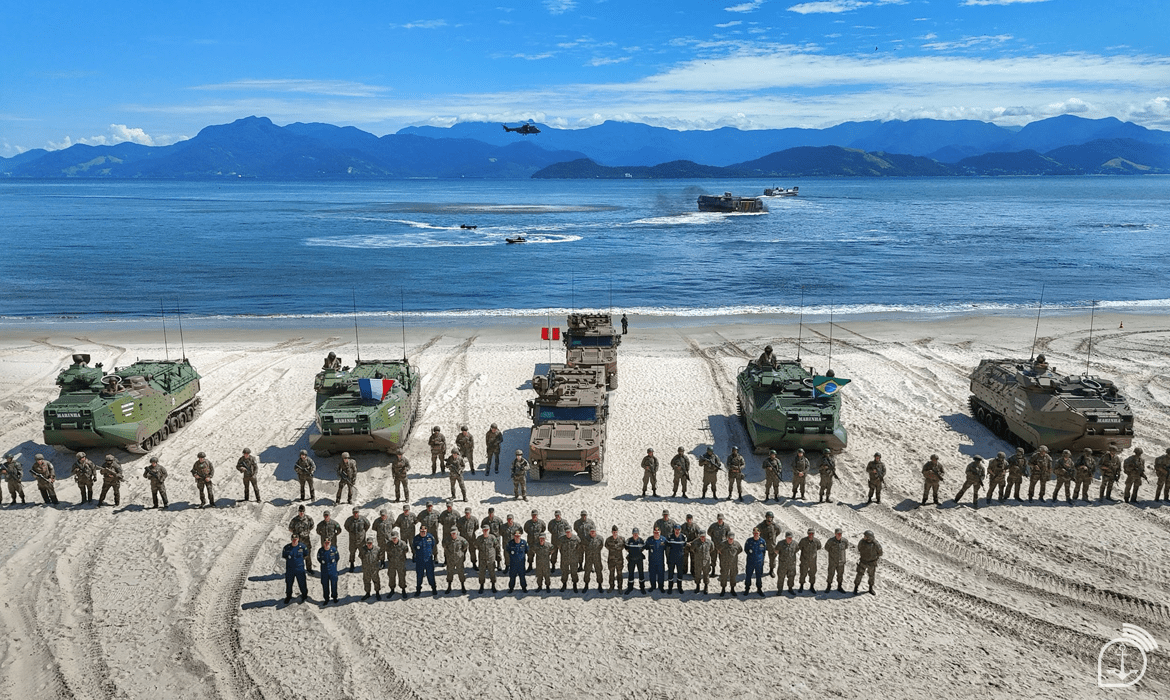The sea phase of Operation “Jeanne d’Arc 2024” was successfully concluded on April 16.
By 1T (RM2-T) Thaís Cerqueira
After three days of intense exercises, the sea phase of Operation “Jeanne d’Arc 2024”, carried out by the Brazilian Navy (MB) with the French Armed Forces, including the French National Navy (MNF) and the 9th Brigade of the French Army, ended on Tuesday (16). One of the highlights of the exercises was the Operational Demonstration of an Amphibious Incursion, held on Marambaia Island (RJ), in the Sepetiba Bay region, on April 15, which included Brazilian and French military assets.
During the Amphibious Incursion Operational Demonstration, Brazilian and French military personnel disembarked on the beach to carry out a simulated mission. Among the participants were Special Operations teams, infiltrated by means of an Operational Free Jump, amphibious units from the Fleet’s Marine Force, as well as landing craft from both countries, which stayed on the beach to disembark the Marines.

The Commander of the Fleet’s 1st Division, Rear Admiral Nelson de Oliveira Leite, Commander of the Combined Amphibious Task Force, recalls that this operation is a unique opportunity to train MB military personnel and to share tactics, techniques and procedures with the French Armed Forces, which also has experience in this type of operation. In addition, he highlighted the importance of training for amphibious incursions, to improve the ability to conquer an objective in hostile territory, through the infiltration of means and troops, with a planned withdrawal, based on the use of Naval, Air and Marine Forces. “In today’s world, in which we have ongoing conflicts, there may be a need for Brazil to remove civilians from a place of interest, and this type of operation carried out here is perfectly suited to that situation. The French Navy, for example, before coming on this mission, was in Haiti withdrawing nationals from that country because of a public security problem,” he said.
For the commander of the amphibious helicopter carrier “Tonnerre” and commander of the French task force “Jeanne d’Arc”, Captain Adrien Jules Marie Schaar, the relationship between the armed forces, especially in the amphibious field, is very close. “This partnership between Brazil and France is long-standing, and has intensified even more with the recent visit of French President Emmanuel Macron to the submarine base in Itaguaí.” The French officer also highlighted the importance of the mission. “We make a five-month trip to Latin America to train the student officers who are embarked and to carry out this type of operation with friendly nations, of which Brazil is the main one in Latin America,” he said.
Approach maneuvers between Brazilian and French ships

During “Jeanne d’Arc 2024”, other training exercises were carried out with the aim of increasing the interoperability of the Forces involved, such as Leap Frog and Light-Line between Brazilian and French ships. These exercises, which simulate maneuvers for the transfer of supplies and personnel between ships at sea, involve skill, as they require the ships to sail very close together, which requires the maneuvering team to be closely monitored throughout the action.
In this combined operation, these two maneuvers were carried out between the Multipurpose Airship “Atlântico” – the flagship of the Brazilian Fleet – and the Frigate “Guépratte” of the French National Navy; and between the Frigate “Liberal”, of the Brazilian Navy, and the French Amphibious Helicopter Carrier “Tonnerre”.
These exercises are all the more necessary because naval forces operating at sea need to maintain their capacity for self-sufficiency, allowing them to operate for a considerable period without the support of their bases.
In the Leap-Frog exercise, the maneuver of approaching ships at close range is practiced, but no cable is passed, and the ship furthest astern begins the approach, remaining on the counter-board for a few minutes. The main purpose of the Light Line, on the other hand, is to pass a distance cable in order to maintain the position between the ships while they sail, both adopting the same course and speed.
These two maneuvers must be carried out in the shortest possible time, so that the ships involved do not become vulnerable targets for a possible attack, since their movements will be restricted.
*** Translated by DEFCONPress FYI Team ***
